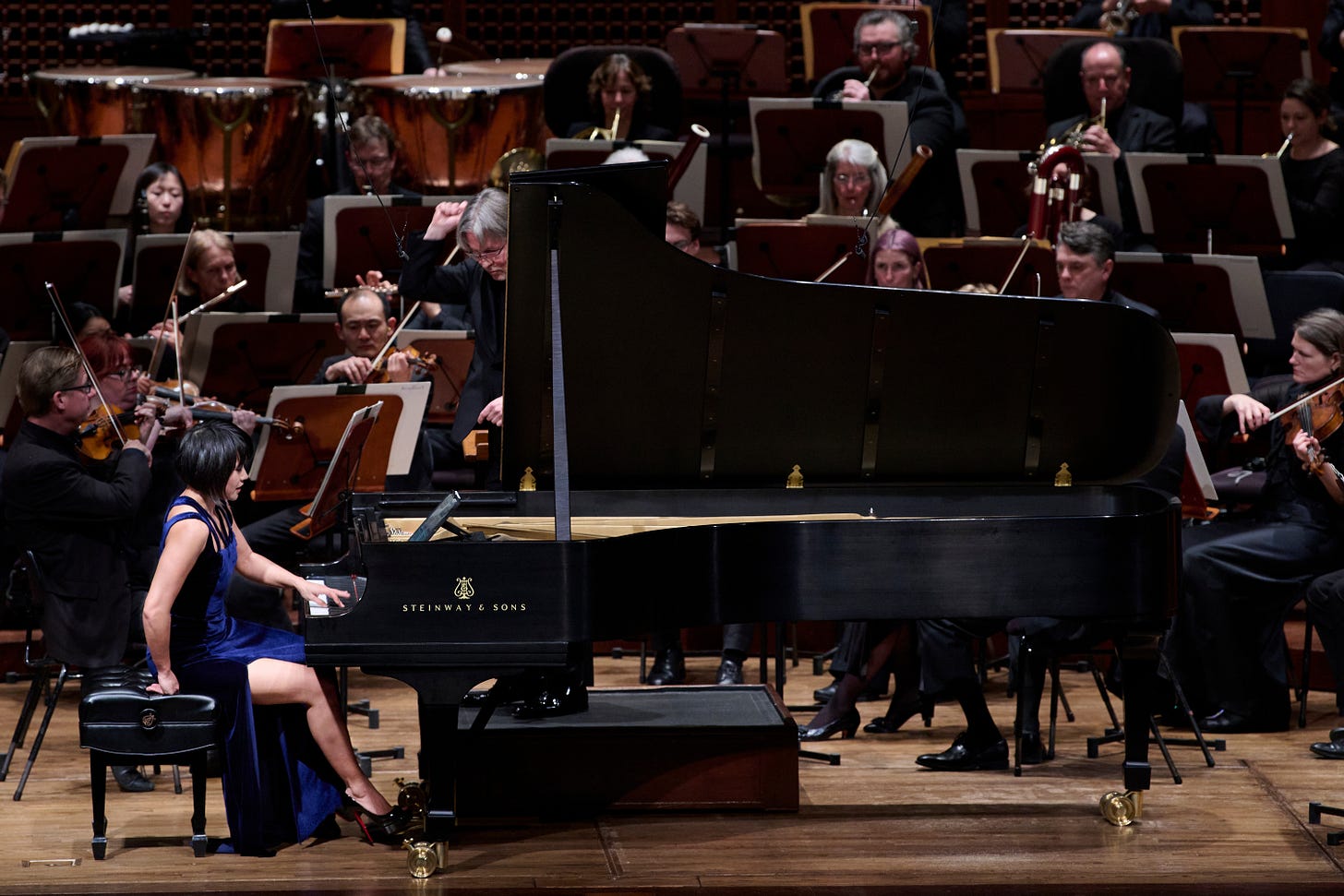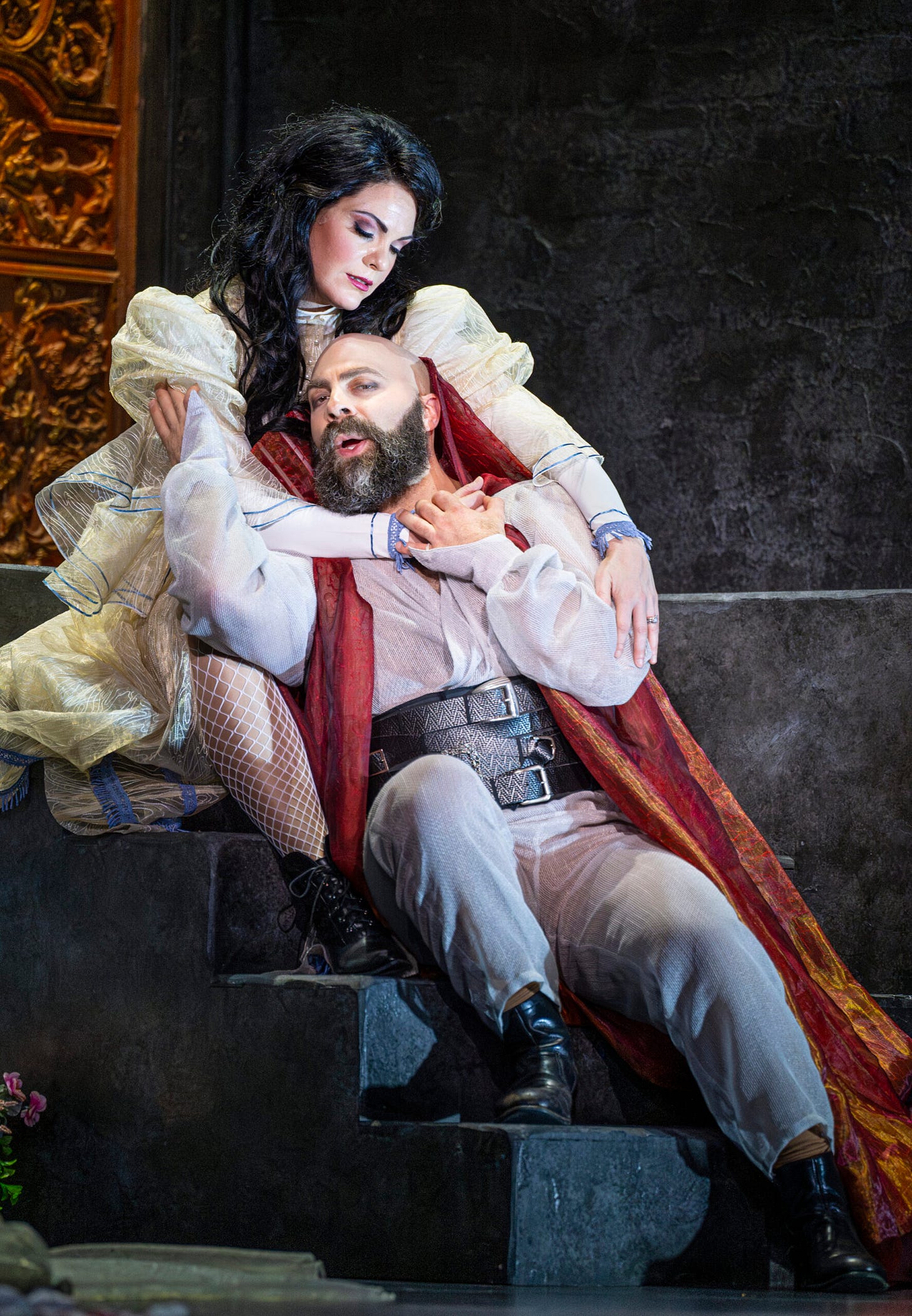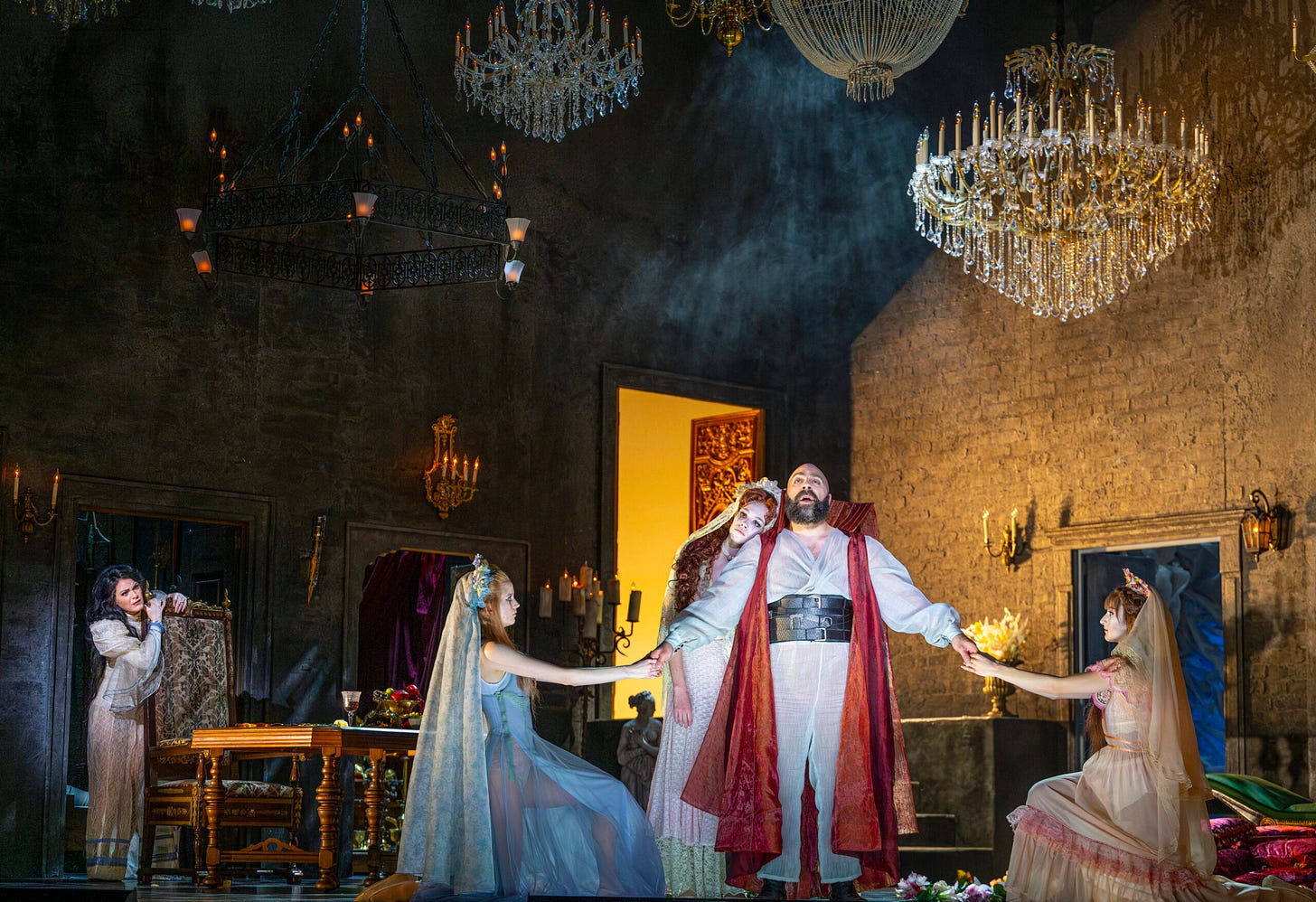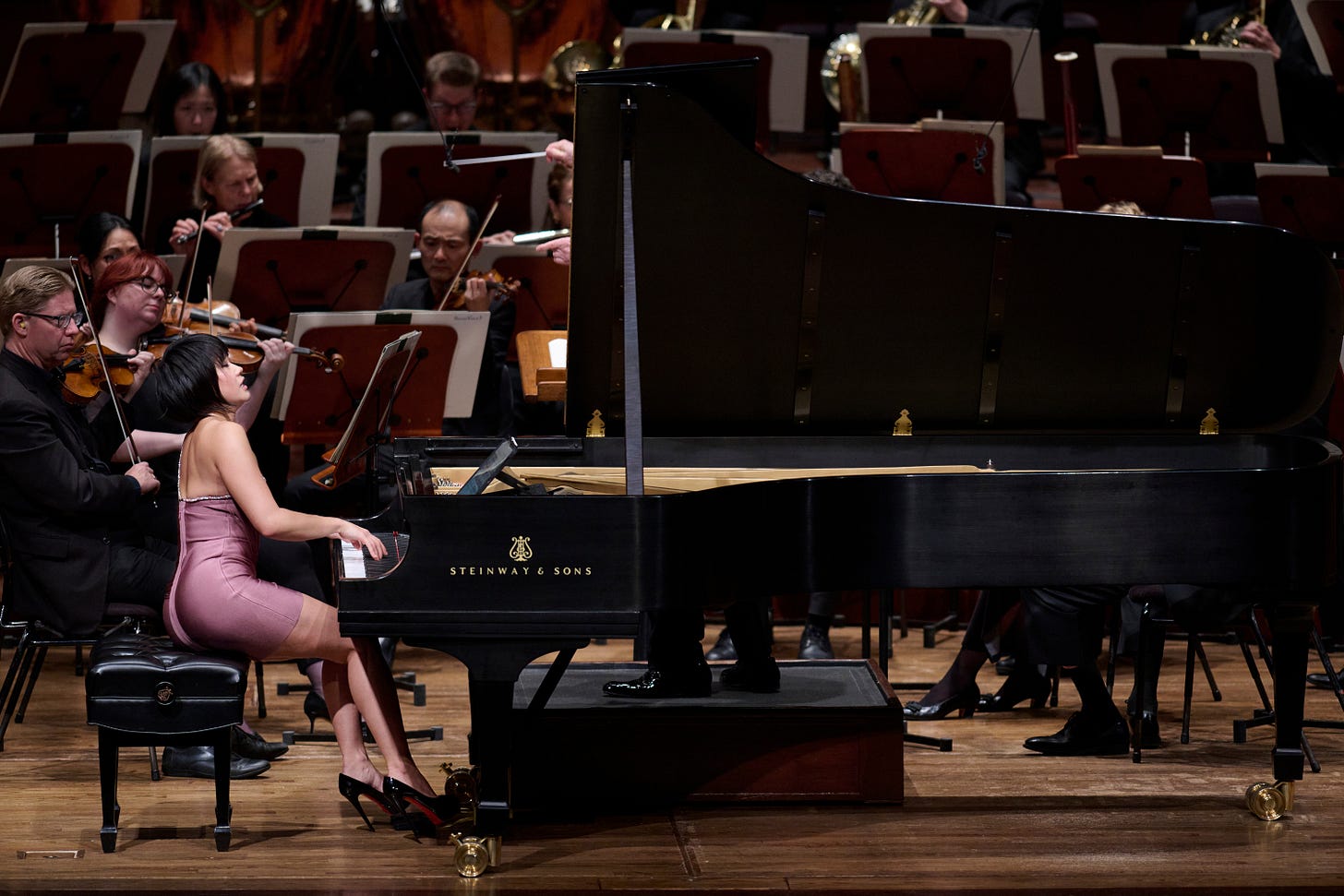
In Bluebeard’s Castle, Bartók’s only opera, the mysterious title character brings his new wife Judith home to his dwelling, which will now become hers. It’s a forbidding locale, dark and chilly and set in a remote part of the hinterlands where no one ever seems to go. A mournful sighing can occasionally be heard echoing through the halls, and the walls drip with moisture that would probably turn out to be blood if anyone had the courage to investigate. Also, there are seven locked doors, and Judith, like the dumbest cast member in the kind of horror movie referenced in Scream and its sequels, is determined to open every last one of them in a way that defies logic or common sense. You want to shake her by the shoulders and holler, “Child, what are you doing?”
Among the virtues of the terrific new Opera San José production of Bluebeard that opened Saturday night at the California Theatre is the fact that director Shawna Lucey makes a serious effort to answer that question. In contrast to more traditional stagings — which tend to treat the piece as a Symbolist horror story with the requisite operatic female victim — this is a production that dares to ask, What if, in addition to a magnificent score, the piece had some psychological and political coherence as well? I’m not convinced Lucey’s solution gets over the difficulties completely, but she gets closer than I’ve ever seen it done.
Lucey, who is also the company’s general director, recasts the opera’s two main characters in new guises, which we might call Sexy Bluebeard and Difficult Judith. Bluebeard is generally depicted as a saturnine lump; in most productions, he looks like a guy with a torture chamber, no sense of humor, and a bunch of ex-wives locked up somewhere. But in baritone Zachary Nelson’s vibrant, vocally powerful account, Bluebeard boasts a wealth of charisma. He laughs, he makes sardonic jokes, he exults in the witty cat-and-mouse game he’s playing with Judith. There’s cruelty there, to be sure — there has to be cruelty — but for once the audience can detect the flame that draws the moth-like Judith to him.
As for Judith herself…well, it’s hard to get a read on her, as it often is under any circumstances. At first I thought we were just getting Loony Judith. Soprano Maria Natale, still in her wedding gown but with her hair splayed out around her in chaotic streams, looks like a cross between Miss Havisham and a troll doll. She writhes with barely concealed excitement as she opens one door after another. She flits about the stage breathlessly. When the penultimate door is unlocked to reveal a pool of tears, Judith drinks from it eagerly. The whole thing seems to be a massive, freaky turn-on for her.
It was only later that I realized I’d done that awful male thing of mistaking female volition for craziness. In Lucey’s vision, Judith isn’t a victim. She’s a problem — for Bluebeard, for his carefully maintained system of secrecy, and for anyone watching who might find himself complicit in any of it. (Lucey also tweaks the opera’s basic plot in a way that not even the racks and pincers from Bluebeard’s torture chamber would induce me to reveal.) Judith insists on opening those doors not because she’s curious, or clueless, but because the whole goddam thing needs to be dismantled, and she’s the person to do it. Maybe there’s some self-portraiture going on here: Bluebeard’s Castle is an opera just waiting to be overturned, and Lucey has pulled it off with inventive panache.
On opening night, every aspect of the production was mutually supportive of every other. Music director Joseph Marcheso conducted with a blend of intimacy and dramatic fervor that made each of the composer’s coloristic strokes — the gleaming gold of the treasure room, the breathtaking white wall of sound representing the panoramic view of Bluebeard’s domain — land perfectly. Instead of bare stone walls and rusty padlocks, designer Steven C. Kemp gave us a luxuriant, quasi-Edwardian parlor, with a cluster of chandeliers overhead and an array of seven doors cartoonishly unalike in size, shape and coloring.
Bluebeard’s Castle is just one act, and runs little more than an hour. It’s always presented in conjunction with something else (most recently, San Francisco Symphony audience members heard it in concert last year alongside Prometheus, Scriabin’s weird and largely pointless orgy of synesthesia). So from an economic perspective, it might be argued that staging the piece alone isn’t really giving subscribers value for their money. But as far as artistic satisfaction is concerned, this would be hard to top.
Bluebeard’s Castle: Opera San José, through March 2. www.operasj.org.
Elsewhere:
Lisa Hirsch, San Francisco Chronicle/SFCV: “Lucey has directed this production with fluid imagination, heightening the dramatic tension as Bluebeard and Judith grapple for power in their marriage. Just what is behind that last door? Will Judith vanish as mysteriously as her husband’s previous wives?”
Let’s play two!

Other pianists offer a single concerto. Yuja Wang performs two, plus encores. I don’t know of another performing artist who exults so wholeheartedly or so infectiously in her own extraordinary talent. (OK, maybe Yo-Yo Ma.) If a listener can’t get enough of her playing, it often feels as if she can’t either.
Wang was in Davies Symphony Hall on Thursday, doing a double-header with Esa-Pekka Salonen and the San Francisco Symphony. The more familiar offering, Ravel’s Left-Hand Concerto, got a wondrously buoyant reading, full of immediacy and fizz; in the march-like scherzo section, which can so often sound unbearably corny, Wang and Salonen built up the music to a point of complete, larger-than-life authenticity.
The novelty on the program, though — which also included Debussy’s complete orchestral suite Images — was the first local performance of the 1969 Piano Concerto No. 1 by the Finnish composer Einojuhani Rautavaara. In his symphonies, Rautavaara writes with a wonderful ear for orchestral sonority, and he evokes the Northern landscape in a way that can sound entirely original. This piece, by contrast, came off as crabbed and derivative. Aside from the opening of the slow movement, in which the pianist delivers a poignant chorale against a shimmery backdrop of muted strings, much of it was full of clattery hubbub; the emergence of fist and forearm clusters in the finale sounded like a composer running of ideas, and fast. Wang’s performance was as exhilaratingly great as ever, but the musical rewards were surprisingly meager.
Elsewhere:
Steven Winn, San Francisco Chronicle/SFCV: “Composed in three movements, the last two played without pause, Rautavaara’s concerto is packed with abundant invention, wit, pathos and muscle — literally. Among the piece’s special effects are a flurry of tone clusters played with the forearm and some rivering glissandos.”
Stephen Smoliar, The Rehearsal Studio: “The two concertos [Wang] performed last night provided an ample account of her capacity for both intricate fingerwork and intense expressiveness.”
Blunt drama
The incarceration of Japanese American citizens during World War II was a terrible crime and a lasting source of shame for the United States. To say that much is not remotely controversial. But neither is it artistic, or interesting, or revelatory. It’s simply a statement of fact.
Both Eyes Open, a 90-minute one-act chamber opera that had two performances over the weekend at Zellerbach Playhouse, proved equally blunt. It tells you things you already know (or should know), and expects you to react to them with fresh outrage and empathy. What’s in short supply is the artistic inventiveness that would take the piece beyond moral platitudes.
Philip Kan Gotanda’s drab libretto traces, in sketchy strokes, the story of a young Japanese American farmer who is plucked off his Stockton farm and shipped to an internment camp in Arkansas. His pregnant wife is sent along with him and dies in the camp, but at bottom this is still his story. (Of course it is, because, y’know, men.) If Gotanda has any insights to offer beyond decrying the injustice and cruelty of the entire episode, they’re hard to detect.
Composer Max Giteck Duykers writes in a heavily percussive style, which is sometimes compellingly dramatic and sometimes just overinsistent, as if he were intent on making sure you understand how terrible this all is. Yet the opera’s most moving and expressive episodes emerge when he dials down the rhetoric, as in an intimate and all-too-brief solo for the wife (sung with electrifying radiance by soprano Zen Wu). Those are the moments when Both Eyes Open invites you into its world, letting you explore the complexities of the characters’ experiences rather than serving up moralistic boilerplate.
Cryptic clue of the week
From Out of Left Field #255 by Henri Picciotto and me, sent to subscribers last Thursday:
Berry and beef (5)
Last week’s clue:
Praise feature of index to librarian (5)
Solution: EXTOL
Praise: definition
feature of: hidden inside
indEX TO Librarian
Coming up
San Francisco Symphony: Xavier Muzik’s Strange Beasts, commissioned by the orchestra as part of its Emerging Black Composers Project in partnership with the San Francisco Conservatory of Music, is due for its world premiere with Esa-Pekka Salonen conducting. This is exactly the kind of program that the brownshirts are now coming after, and this would be a good time to show support. Feb. 21-23, Davies Symphony Hall. www.sfsymphony.org.
American Bach Soloists: The pastoral entertainment Acis and Galatea remains one of Handel’s most irresistibly charming efforts. Funny, romantic, and endearingly bite-sized, it’s the perfect infusion of Handelian vocal writing for when you just don’t have the Sitzfleisch for a full-scale opera or oratorio. Music director Jeffrey Thomas conducts, with a cast that includes tenor James Reese and soprano Nola Richardson in the title roles, and bass-baritone Douglas Ray Williams as the lovelorn giant Polyphemus. Feb. 21-24, locations in Belvedere, Berkeley, San Francisco, and Davis. www.americanbach.org.
Hagen Quartet: All good things come to an end, and the 45-year career of this renowned Austrian ensemble is no exception. The group comes to Cal Performances as part of its final tour before retirement, with a program of string quartets by Haydn and Schumann. Feb. 23, Hertz Hall, UC Berkeley. www.calperformances.org.








